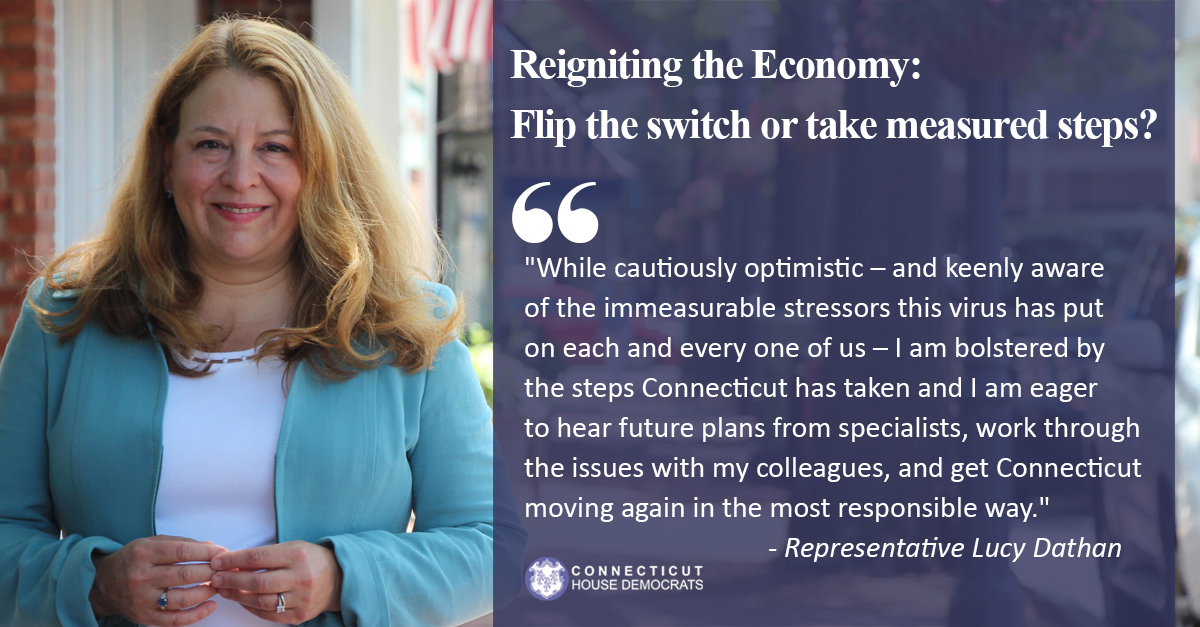Op-Ed: Reigniting the Economy: Flip the switch or take measured steps?

I want to share an Op-ed that I wrote and that was published in our local paper and media.
Reigniting the Economy: Flip the switch or take measured steps?
A strong economy supports every resident.
In the past four weeks, over 320,000 Connecticut residents have filed unemployment claims. This is nearly twice the number of claims typically filed in a year. Armed with 40-year-old software, the Department of Labor (DOL) has been stretched thin by the effort to process these claims. While we currently have federal support to help pay for the administration and related benefits under the CARES Act, many states, including Connecticut, have few reserves to pay their portion for an extended period of time should this funding run out. This shortfall would be deeply detrimental to our economy. Whichever way you look at it we need to start considering a roadmap to return to work and school.
We all want to get workers back to work and children back to school, but turning the economy on like a light switch will put lives in danger. It endangers every single person in our community and in our healthcare system, which would be overburdened by a burgeoning of COVID-19 cases and would particularly jeopardize those who put themselves in harm’s way every day to keep us safe. Further, there is no assurance a person is protected from the disease when the novel coronavirus can infect individuals asymptomatically and cause death even in healthy 30 year olds.
We should all take heart from our collective efforts to ‘flatten the curve’; we have slowed the spread of the virus and impacted the model enough to show a decrease in mortality. To rest on our laurels now and assume this means we can get back to business as usual would, however, be a gross oversight. True, we are slowing the rate of infection, but the virus is still spreading, and has only infected a tiny proportion of the population. It would be a real shame if our strong social distancing measures come to naught simply because we loosened the restrictions too soon. We need to consciously address the risk-benefit analysis that lies at the core of this problem and have an open dialogue around the moral and ethical issues in question.
This is not a political issue – it is a public health issue with economic implications. We are in uncharted territory. It is imperative we work together in a collaborative, methodical manner with the guidance of public health experts to determine best practices in opening up Connecticut’s economy. This involves the legislative leaders from both parties who understand intimately both the state’s businesses and residents.
We do not need to be the first state in the nation to open our schools or our economy; we are expected to peak later than other states. I agree with the Governor’s multi-state approach. Our economy is intricately intertwined with our fellow Northeastern states. We also need to carefully scrutinize Connecticut specifics; a “one size fits all” outlook may not be appropriate with every aspect of our unique economy.
To this end, the Governor has established the Reopen Connecticut Advisory Group co-chaired by Indra Nooyi, the current board Co-chair of AdvanceCT and the former Chairman and CEO of PepsiCo, along with Dr. Albert Ko, who is department Chair and Professor of Epidemiology and Medicine at the Yale School of Public Health. Other senior advisors include Dr. Ezekiel Emanuel, who serves as Vice Provost for Global Initiatives and Chair of the Department of Medical Ethics and Health Policy at the University of Pennsylvania, in addition to Dr. Scott Gottlieb, former Commissioner of the Food and Drug Administration.
This task force of industry and medical leaders will investigate: What metrics will determine when it is safe to open? How do we safely tier the openings of different parts of the economy so as not to overburden our healthcare system? What precautions do we give individual businesses when they open to protect their employees and their customers - does a hairdresser require different rules than, say, a restaurant? What are the limitations of the Federal Stimulus, and how much more will be apportioned? This is just the surface of the framework required to ensure we do not have any unintended and avoidable consequences as we mitigate dangers.
There are many “restart” plans originating from different groups within the political spectrum. It is helpful to look at the operational plans of successful countries. There is a consensus around factors that will make any restart plan viable:
- Test widely at scale – not just diagnostic testing, but also antibody testing.
- Isolate positive cases – either at home or in hospital, as appropriate.
- Contact tracing of positive cases.
- Quarantine probable cases.
Thus far, we are woefully behind in diagnostic testing due to a variety of reasons, and there have been false negatives. It is essential we have accurate testing so that we are able to mass test. Antibody testing, though unfortunately at least a couple weeks away, will prove crucial as a means of determining who has recovered from the disease. We need to continue to isolate the positive cases to guarantee we limit new infections.
According to experts, a key pillar of epidemic containment is also the biggest hurdle: contact tracing people who have tested positive, and quarantining probable cases in the event they are positive in order to reduce the spread. This is a large undertaking, and hopefully we will be assisted by technology. Because nearly everyone has a smartphone, tech companies are looking at the possibility of mobile contact tracing and investigating whether data protection can be maintained.
While cautiously optimistic – and keenly aware of the immeasurable stressors this virus has put on each and every one of us – I am bolstered by the steps Connecticut has taken and I am eager to hear future plans from specialists, work through the issues with my colleagues, and get Connecticut moving again in the most responsible way.





